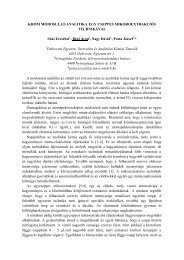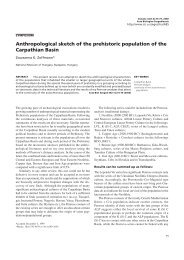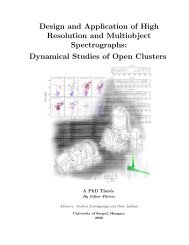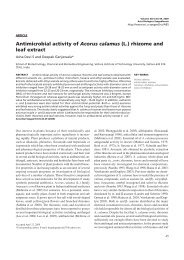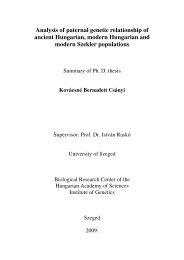principles of extraction and the extraction of semivolatile organics ...
principles of extraction and the extraction of semivolatile organics ...
principles of extraction and the extraction of semivolatile organics ...
Create successful ePaper yourself
Turn your PDF publications into a flip-book with our unique Google optimized e-Paper software.
62 <strong>principles</strong> <strong>of</strong> <strong>extraction</strong><br />
Example<br />
A 1-L aqueous sample containing 100 parts per billion (ppb) <strong>of</strong> a compound<br />
having a molecular weight <strong>of</strong> 250 g/mol is extracted once with 150 mL <strong>of</strong><br />
organic extracting solvent. Assume that <strong>the</strong> KD value is 5. Given this information,<br />
<strong>the</strong> molarity <strong>of</strong> <strong>the</strong> original sample is 4:0 10 10 M. Calculate <strong>the</strong><br />
percent <strong>of</strong> <strong>the</strong> analyte extracted into <strong>the</strong> organic extracting solvent at<br />
equilibrium.<br />
Step 1. Calculate <strong>the</strong> moles <strong>of</strong> analyte in <strong>the</strong> original sample.<br />
Therefore,<br />
moles in original sample ¼ molarity <strong>of</strong> sample ðin mol=LÞ<br />
volume extracted ðin LÞ<br />
moles in original sample ¼ 4:0 10 10 M 1L¼ 4:0 10 10 mol ð2:25Þ<br />
Step 2. Calculate <strong>the</strong> moles <strong>of</strong> analyte left in <strong>the</strong> aqueous phase after <strong>extraction</strong>.<br />
ðmoles in original sample moles left in water after <strong>extraction</strong>Þ=<strong>extraction</strong> solvent volume ðin LÞ<br />
KD ¼<br />
moles left in water after <strong>extraction</strong>=volume <strong>of</strong> original sample ðin LÞ<br />
ð2:26Þ<br />
Therefore,<br />
moles left in water<br />
after <strong>extraction</strong><br />
such that,<br />
moles in original sample<br />
¼<br />
f½KD <strong>extraction</strong> solvent volume ðin LÞŠ=volume <strong>of</strong> original sample ðin LÞg þ 1<br />
moles left in water after <strong>extraction</strong><br />
4:0 10<br />
¼<br />
10 mol<br />
½ð5 0:150 LÞ=1 LŠþ1 ¼ 2:2857 10 10 mol<br />
Step 3. Calculate <strong>the</strong> moles <strong>of</strong> analyte extracted into layer B (i.e., <strong>the</strong><br />
extracting solvent) at equilibrium.<br />
moles <strong>of</strong> analyte extracted into organic solvent<br />
¼ moles <strong>of</strong> analyte in original sample moles left in water after <strong>extraction</strong><br />
¼ 4:0 10 10 mol 2:2857 10 10 mol ¼ 1:7143 10 10 mol ð2:27Þ










